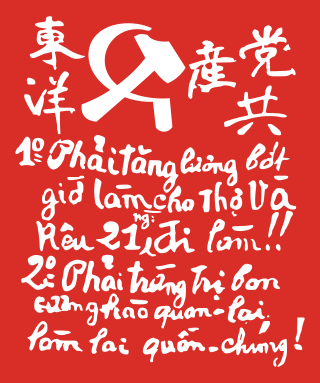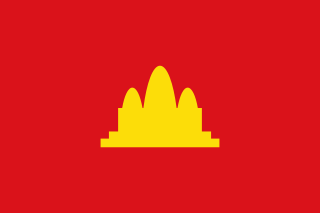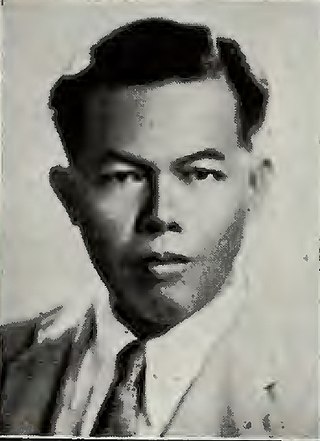Related Research Articles
Benedict F. "Ben" Kiernan is an Australian-born American academic and historian who is the Whitney Griswold Professor Emeritus of History, Professor of International and Area Studies and Director of the Genocide Studies Program at Yale University.

The Indochinese Communist Party (ICP) was a political party which was transformed from the old Vietnamese Communist Party in October 1930. This party dissolved itself on 11 November 1945.

The Khmer People's Liberation Committee was a Cambodian anticolonial movement, formed by Khmer Issarak elements on 1 February 1948. It was later renamed the Khmer National Liberation Committee.

The United Issarak Front was a Cambodian anti-colonial movement 1950–1954, organized by the left-wing members of the Khmer Issarak movement. The UIF coordinated the efforts of the movement as of 1950, and waged war against the French Union forces. At the time of the Geneva Peace Conference in 1954, it is estimated that UIF controlled about half of the Cambodian territory.

Yat Hwaidi was a Khmer politician, born in Surin province, Thailand. During the Second World War, he was the local education supervisor of the Thai administration in Siem Reap. He also represented the Phibunsongkhram Province in the parliament of Thailand. After the war, he joined the Khmer Issarak and pledged allegiance to Dap Chhuon and Kao Tak.
Tiv Ol was a Cambodian teacher and communist politician. Ol joined the Kampuchean People's Revolutionary Party in autumn 1959.
Um Neng, alias Vy, was a Cambodian communist politician. In the early 1960s, he was a leading figure in the Pracheachon Group. At the 1971 congress of the Communist Party of Kampuchea, Um Neng was included in the Central Committee of the party. In 1974 Um Neng became the Deputy Zone Secretary of the CPK in the North-Eastern Zone.
General elections were held in Cambodia on 9 June 1955. The elections were held following the peace established at the 1954 Geneva Conference and the independence of the country. The election were postponed to September 1955. The result was a landslide victory for the Sangkum party, which won all 91 seats. The election was marked by widespread voter fraud and intimidation. This began a period of one-party dominance of Prince Sihanouk's Sangkum until the coup of 1970.
Yos Por, a Cambodian communist politician.
Nguon Hong was a Cambodian Issarak guerrilla chief. Hong led a small group in Kompong Chhnang who has under Savang Vong's command. Around 1952, Nguon Hong and his group defected from Savang Vong, and joined Son Ngoc Thanh's forces. However, Nguon Hong also aligned with the United Issarak Front chief in the area, Meas Vong. In this sense Nguon Hong represented an emerging phenomenon of the unity between nationalist (Thanh) and communist forces in the Cambodian anticolonial struggle at the time.
Keo Meas was a Cambodian communist politician. Keo Meas, then a fourth-year student at the Phnom Penh Teachers Training College, was recruited to the Indochinese Communist Party by Son Sichan in 1946. In 1950, he became a leading figure within the United Issarak Front. At the same time he was a leading figure in the Phnom Penh city unit of the ICP.
Committee to Defend His Majesty's Neutrality Policy was a leftwing political organization in Cambodia, formed in the mid-1950s, by Son Phouc Tho, Touch Phoeun, Hou Yuon and Saloth Chhay. It's assumed that the Committee was modelled after its Vietnamese counterpart, the Committee in Defense of Peace and the Geneva Agreements. The group carried out legal activities. In 1956 the committee published Hou Yuon's doctoral thesis, The Co-operative Question, in Khmer language.
Committee in Defense of Peace and the Geneva Agreements was a political organization in Vietnam, formed in Saigon in August 1954 by Nguyễn Hữu Thọ. The Committee was crushed and banned by the South Vietnamese government in November the same year, and Nguyễn Hữu Thọ and other members of the organization were jailed after a police raid.

Khieu Kanharith is a Cambodian politician and the current Minister of Information.
Tou Samouth, also known as Achar Sok (អាចារ្យសុក), was a Cambodian politician. One of the two founding members of the Kampuchean People's Revolutionary Party (KPRP), the other being Son Ngoc Minh, and head of its more moderate faction. He is mainly remembered for mentoring Saloth Sar, who would later change his name to Pol Pot.
The Krom Pracheachon, often referred to simply as Pracheachon, was a Cambodian political party that contested in parliamentary elections in 1955, 1958 and 1972.

Hem Chieu was a Cambodian Buddhist monk and a prominent figure in the development of Khmer nationalism.
Ampil Tuk is a village on the Tonle Sap River in Kampong Chhnang Province, Cambodia. It lies to the southeast of Kampong Chhnang City and northeast of Oudoum. The village shape is narrow and largely confined to the banks of the river. Ampil Tuk was bombed 8 times in 1973, twice by B-52s, four times by jets and twice by Lon Nol's T-28s. Ampil Tuk is probably best known for its eight-armed Maitreya bronze statue from Wat Ampil Tuk.

The Cambodian genocide was the systematic persecution and killing of Cambodian citizens by the Khmer Rouge under the leadership of Prime Minister of Democratic Kampuchea, Pol Pot. It resulted in the deaths of 1.5 to 2 million people from 1975 to 1979, nearly 25% of Cambodia's population in 1975.
So Phim was a Khmer Issarak, No. 3 of the Permanent Bureau and of the Military Bureau of the Central Committee of the Communist Party of Kampuchea, deputy head of the People's National Liberation Armed Forces of Kampuchea, secretary of East Zone of the Democratic Kampuchea of the Khmer Rouge, until he refused to apply the Cambodian genocide designed by Pol Pot and his comrades causing his death in June 1978.
References
- ↑ Kiernan, Ben. How Pol Pot Came to Power. London: Verso, 1985. p. 153
- ↑ Kiernan, Ben. How Pol Pot Came to Power. London: Verso, 1985. p. 170
- ↑ Kiernan, Ben. How Pol Pot Came to Power. London: Verso, 1985. p. 179
- ↑ Kiernan, Ben. How Pol Pot Came to Power. London: Verso, 1985. p. 188